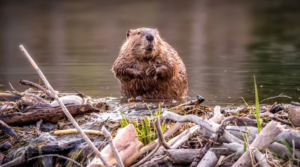I pledge allegiance to the streams
and the beaver ponds of America
And to the renewal for which they stand,
One river, underground, irreplaceable
With habitat and wetlands for all
I’ve been hearing a lot about this book lately, and coming across beaver believers who recommend it highly. So I thought we should spend some time thinking about it. The author Erica Gies is an author and accomplished journalist. She’s the kind of women who’s seen things all around the world, so when she talks, we should listen.
 For her new book, Water Always Wins, National Geographic Explorer Erica Gies criss-crossed the globe, witnessing some of the unanticipated results of modern society’s preference for engineered solutions.
For her new book, Water Always Wins, National Geographic Explorer Erica Gies criss-crossed the globe, witnessing some of the unanticipated results of modern society’s preference for engineered solutions.
The tendency to hem water in and wrestle to alter its natural course with enormous dams and ever-higher dikes, straightened rivers and hardened shores often exacerbate the symptoms of global warming, the environmental journalist found.
But an array of microbes, animals, and communities enjoy beneficial relationships with this vital element by harmonizing with water’s wishes, Gies discovered. As such, her book explores hopeful and resilient approaches to working with water that respect its natural flow and rhythms, with positive outcomes for humans, biodiversity and the climate.
Hmm. Got your attention yet? What does water want? Well might you ask young Jedi. It almost always has seemed to me that water wants the freedom to move where it chooses and rest when it feels like it. But Erica has different ideas.
“Basically, what water wants is a return to its slow phases that we have dramatically eradicated with much of our development,” Gies said.
As much as 87 per cent of the world’s wetlands have been eradicated since the 1700s, and humans have heavily encroached on floodplains worldwide, risking homes and businesses should water reassert its return, she said.
There are so many examples of the folly associated with interfering with the natural filter, trickle or spread of water, Gies said, pointing to California, the poster child of perpetual drought.
“California is arguably the apex of water engineering hubris,” Gies said.
Now that’s interesting to me. I never thought of California as spectacularly worse than any other large state at managing water. But maybe because are so long. From wet to dry. I wonder if the reason California pretended to forget it had beavers was because it needed to focus on its own water management needs and get theirs out of the way.
Since the mid-19th century, the corralling of two great watercourses, the Sacramento and the San Joaquin rivers, has eliminated the historic annual flushing of the Central Valley — once a vast floodplain — drying it out and denying vital aquifers below an opportunity to top themselves up, she said.
Compounding the problem, the rivers’ water is funnelled vast distances across the state while the region’s groundwater is heavily tapped to fuel California’s vast agricultural empire — helping in part to create a critical shortage of water in areas where it once existed in abundance.
Surface water and groundwater are mutually entwined, Gies said.
“We have deprived the natural recharge that happens when the water slows on those lands and moves underground,” Gies said. And in reverse, stressed aquifers can’t help recharge rivers and tributaries at the surface during the dry season.
“For a long time, California had this sort of political attitude that they were dealing with two separate sources of water that could be regulated independently, or in the case of groundwater, not regulated (at all).”
Yes I guess we did forget that all water is the same. And that when you deplete one bank you run out of funds in the other. You know who didn’t forget? Beavers that’s who.
 “But beavers are incredibly important for the health of the hydrological cycle, and they’re being used in different places around the world to help protect against drought, wildfire and also flooding.”
“But beavers are incredibly important for the health of the hydrological cycle, and they’re being used in different places around the world to help protect against drought, wildfire and also flooding.”
Gies dedicates a full chapter to the multitude of ways we can better our relationship with water by relying on and living with beavers.
The skill of these once ubiquitous mammals has been recognized by U.S. authorities, who on various occasions in the past parachuted beavers into wilderness areas to restore watersheds.
Slow-water projects, principles, and solutions are unique to each location, community, and culture, she added. But there are some common principles.
“I think it’s really about respecting water and appreciating the benefits that collaboration can bring.”
Can I get an amen? I know why Stanford referred to you in its water in the west study. You can see the writing on the wall. And it’s been written by beavers.






 For her new book, Water Always Wins, National Geographic Explorer Erica Gies criss-crossed the globe, witnessing some of the unanticipated results of modern society’s preference for engineered solutions.
For her new book, Water Always Wins, National Geographic Explorer Erica Gies criss-crossed the globe, witnessing some of the unanticipated results of modern society’s preference for engineered solutions. “But beavers are incredibly important for the health of the hydrological cycle, and they’re being used in different places around the world to help protect against drought, wildfire and also flooding.”
“But beavers are incredibly important for the health of the hydrological cycle, and they’re being used in different places around the world to help protect against drought, wildfire and also flooding.”





































